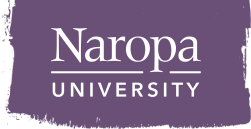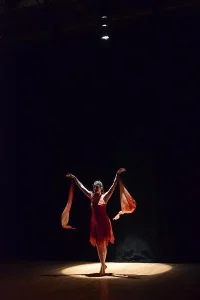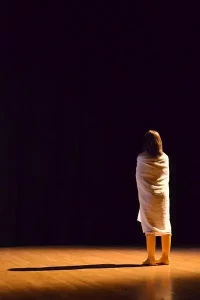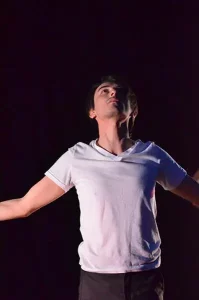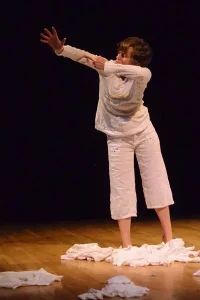About the Program
The Somatic Counseling programs look at the relationship between the mind and body as a dance: as one goes, so goes the other.
Grounded in the assumption that the body (soma in Greek) can be used to help individuals transform, this cohort program will give you the academic, experiential, and contemplative experience necessary to begin a compassionate, clinical practice.
Distinguished by a curriculum that emphasizes mindfulness and moving meditation as well as diversity and community engagement, Naropa’s Somatic Counseling programs will help transform you into a deeply aware therapist passionate about helping others create change in their bodies, minds, and lives.
Select Program Highlights
Philosophy of Learning
The Somatic Counseling: Body Psychotherapy and Somatic Counseling: Dance/Movement Theories & Practice concentrations provide students with the theoretical, clinical, and professional skills to be effective psychotherapists grounded in the integration of body, mind, and movement.
The programs base their philosophy on the belief that a functional unity exists between the mind and the body and that direct, unconditional experience of the present moment is, in and of itself, healing. A vital and basic way to experience the present moment is to fully occupy one’s own body.
Combined with movement and action that expresses one’s essence and striving to be of service, health is seen as a graceful dance with one’s inner and outer worlds.
The activity of therapy, then, involves removing learned obstructions to full-bodied awareness, owning, appreciation, and action.
Holistic Study
Course offerings are designed to create a matrix of learning in which study in each area connects and complements study in other areas. While students are focusing on one class, they are challenged to address the perspectives and connections provided by other classes.
Master’s Paper
In the third year of the program, all students will write a master’s paper, a scholarly work on a topic relevant to the area of study in which you are being trained (always involving Body Psychotherapy or Dance/Movement Therapy). This process is an opportunity for self-discovery and to demonstrate your skills as a theoretician, researcher, or activist.
Practicum & Internships: Community-Based Learning
Students in the program are required to complete both a practicum and a 700-hour clinical internship that incorporates meaningful service and is an opportunity to observe and participate in the mental health community, and in the community in general, as a therapist in training. Through the practicum and internship experiences, students become acquainted with different populations as well as become more comfortable with their community.
Beliefs & Values
The following departmental beliefs serve as a guiding principles in the deliver of our course content:
- Human beings are by nature whole and oriented toward growth.
- Human beings are, at birth, equipped with the rudimentary ability to discriminate between what is unhealthy and what is nurturing for them.
- One human being cannot “cure” another. A therapist provides an environment of structure, safety, and skill through which the client helps themselves.
- Healing skills include attention, empathy, compassion, nonaggressive behavior, an appreciation for uncertainty, an ability to tolerate discomfort and a basic commitment to do no harm.
- Healing is always a system process involving self, environment and the interaction between both.
- Expressive and natural movement is a powerful tool that serves to synchronize healing.
- Contemplative disciplines are powerful tools in healing. In the training of therapists, they cultivate the qualities of presence, attention, awareness, and compassion.
The Somatic Counseling Department values:
- A fundamental view of humanity as whole and oriented towards growth.
- Training our students to grow, develop, and support the wellness and sanity in their clients rather than to focus only on eliminating their illness.
- Learning experiences that synchronize and integrate experience and expression on a physical, emotional, cognitive, energetic, and spiritual level.
- Developing a sense of community and an environment of co-creativity within the department, the University and the surrounding community.
- Communication based on an acknowledgment of individuality and diversity.
- We believe that understanding and working with others is ultimately based on understanding and working with one’s own personal dynamic.
Suggested Reading
We recommend the following reading in order to gain exposure to somatic counseling psychology concepts before beginning the program.
Body Psychotherapy
Aposhyan, S. (1999). Natural Intelligence: Body-mind integration and human development. Baltimore, MD: Williams and Wilkens.
Bainbridge Cohen, B. (1993). Sensing, feeling, and action: The experiential anatomy of Body-Mind Centering. Northampton, MA: Contact Editions.
Caldwell, C. (1997). Getting in touch: The guide to new body-centered psychotherapies. Wheaton, IL: Quest Books.
Hartley, L. (1995). Wisdom of the body moving: An introduction to Body-Mind Centering. Berkeley, CA: North Atlantic Books.
Johnson, D., & Grand, I. J. (Eds.). (1998) The body in psychotherapy: Inquiries in somatic psychology. Berkeley, CA, North Atlantic Books.
Keleman, S. (1981). Your body speaks its mind. Berkeley, CA: Center Press.
Kepner, J. I. (1993). Body process: Working with the body in psychotherapy. San Francisco CA: Jossey-Bass Inc.
Kurtz, R. (1990). Body-centered psychotherapy – the Hakomi method: The integrated use of mindfulness, nonviolence, and the body. Mendocino, CA: LifeRhythm.
Rosenberg , J., & Rand, M. (1985) Body, self, and soul: Sustaining integration. Atlanta, GA: Humanics, Ltd.
Smith, E. W. L. (1985). The body in psychotherapy. Jefferson, NC: McFarland and Company, Inc.
Dance/Movement Therapy
Bartenieff, I., & Lewis, D. (1980). Body movement: Coping with the environment. New York, NY: Gordon and Breach, Science Publishers, Inc.
Caldwell, C. (1996). Getting our bodies back: Recovery, healing, and transformation through body-centered psychotherapy. Boston, MA: Shambhala Publications, Inc.
Chodorow, J. (1991). Dance therapy and depth psychology: The moving imagination. New York, NY: Routledge.
Espenak, L. (1981). Dance therapy: Theory and application. Springfield, IL: Charles C. Thomas.
Kestenberg Amighi, J., Loman, S., Lewis, P., & Sossin, K. M. (1999). The meaning of movement: Developmental and clinical perspectives of the Kestenberg Movement Profile. Amsterdam, The Netherlands: Gordon and Breach Publishers.
Levy, F. J. (1988). Dance movement therapy: A healing art. Reston, VA: The American Alliance for Health, Physical Education, Recreation, and Dance.
Levy, F. J. (1995). Dance and other expressive arts therapies: When words are not enough. New York, NY: Routledge.
Sandel, S. J., Chaiklin, S., & Lohn, A. (1993). Foundations of dance/movement therapy: The life and work of Marian Chace. Columbia, MD: Marian Chace Memorial Fund; American Dance Therapy Association.
Schoop, T., & Mitchell, P. (1974). Won’t you join the dance?: A dancer’s essay into the treatment of psychosis. New York, NY: Mayfield Publishing Company.
Siegel, E. V. (1984). Dance-movement therapy: Mirror of ourselves. The psychoanalytic approach. New York, NY: Human Sciences Press, Incorporated.
Somatic Arts Concert
The Somatic Arts Scholarship Concert is an annual student directed event sponsored by the Somatic Counseling Program. The concert was originally conceived of in 1996 by Paola Faggella, a Dance/Movement Therapy student, and Janice Beard-Bull, former director of the Somatic Counseling department, both of whom were invested in exploring the interface of art making and therapeutic training. The concert brings students, family, faculty and the Boulder community together to witness the creative and healing powers of embodied performance.Naropa University was one of the first institutions in the nation to offer a degree in somatic counseling psychology. The twenty-two-year-old Master of Arts program is based on the belief that a functional unity exists between the mind and body and that therapeutic change occurs through direct experience of the present moment.
Alumni Careers
Cheryl Burns, MA, Somatic Counseling: Dual concentration, 2011
A practicing Butoh dancer and massage therapist from Georgia, Cheryl Burns has long wondered what makes people tick. While attending high school literature and neurochemistry classes, she would wonder about the psychology of novel characters. What were their motivations? To what degree were their personalities a result of biology and chemistry? At home, the questions took on a different context.
“My older sister suffered a brain injury when I was a baby,” says Burns. “My role has always been informed by the reality that I am the only one in our family who has known her only post-injury. I feel that my connection with her has fueled my curiosities about the psychological changes she experienced and the challenges she continues to face.”
Eventually, Burns participated in Naropa study abroad to India where she encountered Buddhism and its accompanying theories of the mind. As she advanced in contemplative practice and the performing arts, she discovered Naropa’s Somatic Counseling Department, which “pulled together these seemingly disparate pieces” of herself.
“I’m fascinated,” she says, “by the neurobiological processes that reveal the ‘bodymind,’ a unity of the brain/nervous system and the entire body. I love that our program emphasizes this science along with studies of the intangible, ephemeral end of the spectrum.”
Since graduating in May, 2011 Burns has been working to open her somatic psychotherapy practice that combines Jungian theories and expressive art therapies, as well as work toward a Licensed Professional Counselor certification. “I feel particularly grateful for the ways this program supports awareness and action concerning diversity issues,” she says, “because I feel that we are stepping into roles as healers who work with systems as well as individuals.”
Where are our graduates working?
What can you do with a degree in Clinical Mental Health Counseling, Somatic Counseling Concentrations?
- Individual/Family Therapist, The Eliot Center; Concord, MA
- Home-Based Therapist/Adoption Specialist, Mental Health Center of Boulder and Broomfield Counties; Boulder, CO
- Dance/Movement Therapist/Licensed Creative Arts Therapist, Long Beach Medical Center Acute Inpatient Psych Unit; Long Beach, NY
- Clinical Director, Sage Education Center: Minneapolis, MN
- Psychotherapist, Rainrock Treatment Center for Eating Disorders; Eugene, OR
- Senior Consultant/Executive Coach, MDA Leadership Consulting Company; Minneapolis, MN
- Clinical Supervisor, Noeticus Counseling Center, Denver, CO
- Clinical Director, Restorative Resources Consulting and Training, Santa Fe, NM
- Instructor/Faculty Development Coordinator, Columbia College; Chicago, IL
- Dance/Movement Therapist, The Children’s Hospital; Aurora, CO
- Program Coordinator/Clinical Case Manager, Walden Behavioral Care; Waltham, MA
- Psychotherapist, Katherine Freer Wilderness Therapy Programs; Albany, OR
- Bilingual Women’s Counselor, Safehouse Progressive Alliance for Non-Violence; Boulder, CO
- Health & Wellness Coordinator, San Pasqual Academy; San Diego, CA
- Social-Emotional Wellness Coordinator, Early Head Start; Baltimore, MD
- Program Director, Center for Change; Boulder, CO
- Family Therapist, Larimer Center for Mental Health; Fort Collins, CO
- Movement Therapist, Longmont United Hospital; Longmont, CO
- Adult Outpatient Psychotherapist, Mental Health Center of Boulder and Broomfield Counties; Boulder, CO
- Dance/Movement Therapist: Creative Art Therapy Team, Mt. St. Vincent Home; Denver, CO
- Author and EMDRIA Approved Consultant and Trainer in Private Practice, Boulder, CO
- Bilingual Children’s Counselor, Safehouse Progressive Alliance for Non-Violence; Boulder, CO
- Author, Instructor, Clinician in Private Practice; Cape Town, South Africa
- Students demonstrate knowledge of core counseling curriculum.
- Students demonstrate proficiency in clinical counseling skills.
- Students demonstrate professional competence in counseling.
- Students demonstrate the ability to research and write about Dance/Movement Therapy (DMT) and Body Psychotherapy (BP) in a way that shows critical thinking, scholarship, and the integration of theoretical material with clinical practice.
- Students demonstrate the ability to develop and use appropriate counseling and DMT/BP interventions when working with clients.
- Students demonstrate the knowledge of and ability to practice the professional ethics and standards for DMTs/BPs and professional counselors, including the ability to self-regulate and self-evaluate; accept and integrate supervision; and address power and privilege both in the therapeutic relationship and within the institution.
- Students internalize and manifest pluralism and multicultural competency as an integral part of clinical practice, including an ability to recognize and appreciate differences in people’s experiences of their bodies and their movement patterns.
- Students develop a moment-to-moment embodiment of their experience, which includes feeling sensations, awareness of emotions, occupying the body, and tracking movements and thoughts.
